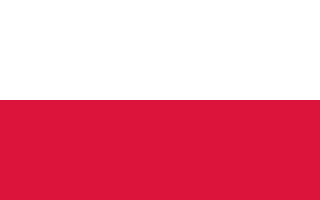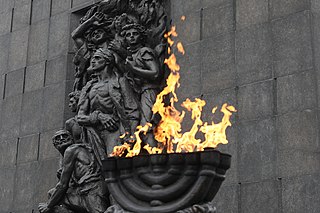
Gdańsk is a city on the Baltic coast of northern Poland. With a population of 470,621, Gdańsk is the capital and largest city of the Pomeranian Voivodeship. It is Poland's principal seaport and the country's fourth-largest metropolitan area.

The Second Polish Republic, at the time officially known as the Republic of Poland, was a country in Central and Eastern Europe that existed between 7 October 1918 and 30 September 1939. The state was established in the final stage of World War I. The Second Republic ceased to exist in 1939, after Poland was invaded by Germany, the Soviet Union, and the Slovak Republic, marking the beginning of the European theatre of the Second World War. The Polish government-in-exile was established in Paris to replace the Second Republic in the war.

Kraków, less often spelled Cracow in English, is the second-largest and one of the oldest cities in Poland. Situated on the Vistula River in Lesser Poland Voivodeship, the city dates back to the seventh century. Kraków was the official capital of Poland until 1596 and has traditionally been one of the leading centres of Polish academic, economic, cultural and artistic life. Cited as one of Europe's most beautiful cities, its Old Town with Wawel Royal Castle was declared a UNESCO World Heritage Site in 1978, one of the world's first sites granted the status.

Poland, officially the Republic of Poland, is a country in Central Europe. It is divided into 16 administrative provinces called voivodeships, covering an area of 313,931 km2 (121,209 sq mi). Poland has a population of over 38 million and is the fifth-most populous member state of the European Union. Warsaw is the nation's capital and largest metropolis. Other major cities include Kraków, Gdańsk, Wrocław, Katowice, Łódź, Poznań, Szczecin and Lublin.

Polish is a West Slavic language of the Lechitic group written in the Latin script. It is spoken primarily in Poland and serves as the native language of the Poles. In addition to being the official language of Poland, it is also used by the Polish diaspora. There are over 50 million Polish speakers around the world. It ranks as the sixth most-spoken among languages of the European Union. Polish is subdivided into regional dialects and maintains strict T–V distinction pronouns, honorifics, and various forms of formalities when addressing individuals.

Szczecin is the capital and largest city of the West Pomeranian Voivodeship in northwestern Poland. Located near the Baltic Sea and the German border, it is a major seaport and Poland's seventh-largest city. As of December 2021, the population was 395,513.

Warsaw, officially the Capital City of Warsaw, is the capital and largest city of Poland. The metropolis stands on the River Vistula in east-central Poland. Its population is officially estimated at 1.86 million residents within a greater metropolitan area of 3.1 million residents, which makes Warsaw the 6th most-populous city in the European Union. The city area measures 517 km2 (200 sq mi) and comprises 18 districts, while the metropolitan area covers 6,100 km2 (2,355 sq mi). Warsaw is an alpha global city, a major cultural, political and economic hub, and the country's seat of government. It is also capital of the Masovian Voivodeship.

Wrocław is a city in southwestern Poland and the largest city in the historical region of Silesia. It lies on the banks of the River Oder in the Silesian Lowlands of Central Europe, roughly 40 kilometres (25 mi) from the Sudeten Mountains to the south. As of 2022, the official population of Wrocław is 673,923 making it the third largest city in Poland.

Lviv is the largest city in western Ukraine, and the sixth-largest in Ukraine, with a population of 717,273. It serves as the administrative centre of Lviv Oblast and Lviv Raion, and is one of the main cultural centres of Ukraine. Lviv also hosts the administration of Lviv urban hromada. It was named in honour of Leo, the eldest son of Daniel, King of Ruthenia.

The złoty is the official currency and legal tender of Poland. It is subdivided into 100 grosz (gr). It is the most traded currency in Central and Eastern Europe and ranks 21st most-traded in the foreign exchange market.

Poles, or Polish people, are a West Slavic ethnic group and nation who share a common history, culture, the Polish language and are identified with the country of Poland in Central Europe. The preamble to the Constitution of the Republic of Poland defines the Polish nation as comprising all the citizens of Poland, regardless of heritage or ethnicity. The majority of Poles adhere to Roman Catholicism.

The Invasion of Poland, also known as the September Campaign, Polish Campaign, War of Poland of 1939, and Polish Defensive War of 1939, was a joint attack on the Republic of Poland by Nazi Germany, the Slovak Republic, and the Soviet Union; which marked the beginning of World War II. The German invasion began on 1 September 1939, one week after the signing of the Molotov–Ribbentrop Pact between Germany and the Soviet Union, and one day after the Supreme Soviet of the Soviet Union had approved the pact. The Soviets invaded Poland on 17 September. The campaign ended on 6 October with Germany and the Soviet Union dividing and annexing the whole of Poland under the terms of the German–Soviet Frontier Treaty. The invasion is also known in Poland as the September campaign or 1939 defensive war and known in Germany as the Poland campaign.

The Polish–Lithuanian Commonwealth, formally known as the Kingdom of Poland and the Grand Duchy of Lithuania, or simply Poland–Lithuania, was a bi-confederal state, sometimes called a federation, of Poland and Lithuania ruled by a common monarch in real union, who was both King of Poland and Grand Duke of Lithuania. It was one of the largest and most populous countries of 16th- to 17th-century Europe. At its largest territorial extent, in the early 17th century, the Commonwealth covered almost 1,000,000 km2 (400,000 sq mi) and as of 1618 sustained a multi-ethnic population of almost 12 million. Polish and Latin were the two co-official languages.

The Polish–Soviet War was fought primarily between the Second Polish Republic and the Russian Soviet Federative Socialist Republic in the aftermath of World War I and the Russian Revolution, on territories which were formerly held by the Russian Empire and the Austro-Hungarian Empire.

The Polish People's Republic, or simply Poland, was a country in Central Europe that existed from 1947 to 1989 as the predecessor of the modern-day Republic of Poland. With a population of approximately 37.9 million near the end of its existence, it was the second most-populous communist and Eastern Bloc country in Europe. A unitary state with a Marxist–Leninist government, it was also one of the main signatories of the Warsaw Pact alliance. The largest city and official capital since 1947 was Warsaw, followed by the industrial city of Łódź and cultural city of Kraków. The country was bordered by the Baltic Sea to the north, the Soviet Union to the east, Czechoslovakia to the south, and East Germany to the west.

The Warsaw Uprising was a major World War II operation by the Polish underground resistance to liberate Warsaw from German occupation. It occurred in the summer of 1944, and it was led by the Polish resistance Home Army. The uprising was timed to coincide with the retreat of the German forces from Poland ahead of the Soviet advance. While approaching the eastern suburbs of the city, the Red Army halted combat operations, enabling the Germans to regroup and defeat the Polish resistance and to destroy the city in retaliation. The Uprising was fought for 63 days with little outside support. It was the single largest military effort taken by any European resistance movement during World War II.

The history of the Jews in Poland dates back at least 1,000 years. For centuries, Poland was home to the largest and most significant Ashkenazi Jewish community in the world. Poland was a principal center of Jewish culture, because of the long period of statutory religious tolerance and social autonomy which ended after the Partitions of Poland in the 18th century. During World War II there was a nearly complete genocidal destruction of the Polish Jewish community by Nazi Germany and its collaborators of various nationalities, during the German occupation of Poland between 1939 and 1945, called the Holocaust. Since the fall of communism in Poland, there has been a renewed interest in Jewish culture, featuring an annual Jewish Culture Festival, new study programs at Polish secondary schools and universities, and the opening of Warsaw's Museum of the History of Polish Jews.

The Polish Air Force is the aerial warfare branch of the Polish Armed Forces. Until July 2004 it was officially known as Wojska Lotnicze i Obrony Powietrznej. In 2014 it consisted of roughly 16,425 military personnel and about 475 aircraft, distributed among ten bases throughout Poland.

On 10 April 2010, a Tupolev Tu-154 aircraft operating Polish Air Force Flight 101 crashed near the Russian city of Smolensk, killing all 96 people on board. Among the victims were the president of Poland, Lech Kaczyński, and his wife, Maria, the former president of Poland in exile, Ryszard Kaczorowski, the chief of the Polish General Staff and other senior Polish military officers, the president of the National Bank of Poland, Polish Government officials, 18 members of the Polish Parliament, senior members of the Polish clergy, and relatives of victims of the Katyn massacre. The group was arriving from Warsaw to attend an event commemorating the 70th anniversary of the massacre, which took place not far from Smolensk.

The Armed Forces of the Republic of Poland are the national armed forces of the Republic of Poland. The name has been used since the early 19th century, but can also be applied to earlier periods.


















